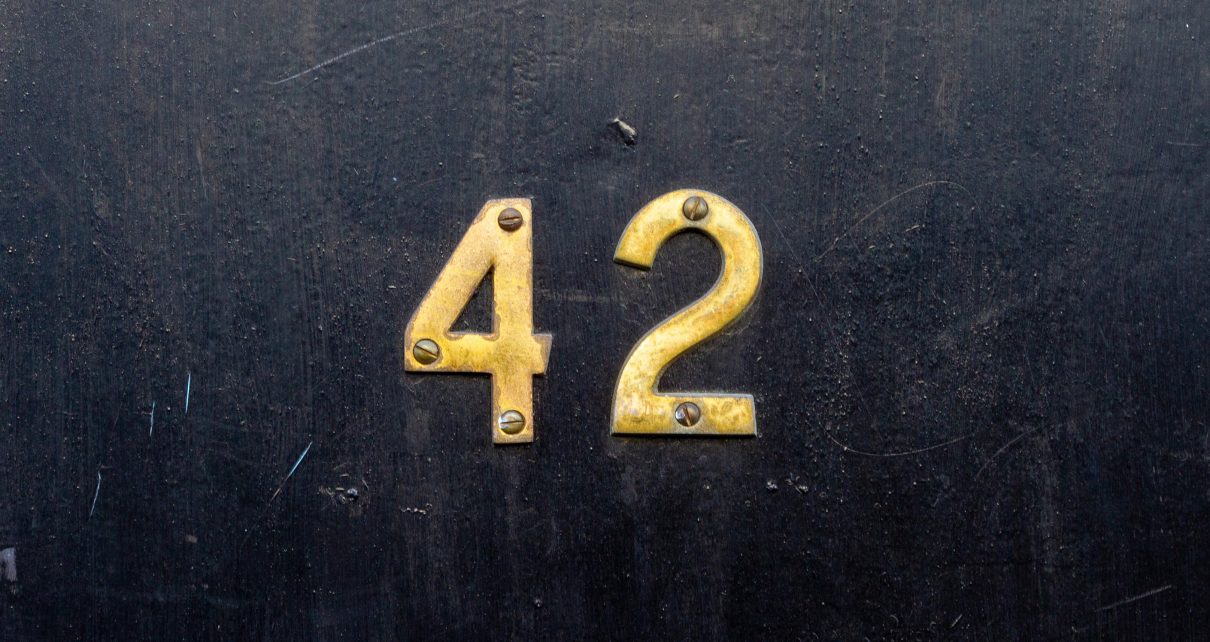Everyone loves unsolved mysteries. Examples include Amelia Earhart’s disappearance over the Pacific in 1937 and the daring escape of inmates Frank Morris and John and Clarence Anglin from Alcatraz Island in California in 1962. Moreover our interest holds even if the mystery is based on a joke. Take author Douglas Adams’s popular 1979 science-fiction novel The Hitchhiker’s Guide to the Galaxy, the first in a series of five. Toward the end of the book, the supercomputer Deep Thought reveals that the answer to the “Great Question” of “Life, the Universe and Everything” is “forty-two.”
Deep Thought takes 7.5 million years to calculate the answer to the ultimate question. The characters tasked with getting that answer are disappointed because it is not very useful. Yet, as the computer points out, the question itself was vaguely formulated. To find the correct statement of the query whose answer is 42, the computer will have to build a new version of itself. That, too, will take time. The new version of the computer is Earth. To find out what happens next, you’ll have to read Adams’s books.
The author’s choice of the number 42 has become a fixture of geek culture. It’s at the origin of a multitude of jokes and winks exchanged between initiates. If, for example, you ask your search engine variations of the question “What is the answer to everything?” it will most likely answer “42.” Try it in French or German. You’ll often get the same answer whether you use Google, Qwant, Wolfram Alpha (which specializes in calculating mathematical problems) or the chat bot Web app Cleverbot.
Since the first such school was created in France in 2013 there has been a proliferation of private computer-training institutions in the “42 Network,” whose name is a clear allusion to Adams’s novels. Today the founding company counts more than 15 campuses in its global network. he number 42 also appears in different forms in the film Spider-Man: Into the Spider-Verse. Many other references and allusions to it can be found, for example, in the Wikipedia entry for “42 (number).”
The number 42 also turns up in a whole string of curious coincidences whose significance is probably not worth the effort to figure out. For example:
In ancient Egyptian mythology, during the judgment of souls, the dead had to declare before 42 judges that they had not committed any of 42 sins.
The marathon distance of 42.195 kilometers corresponds to the legend of how far the ancient Greek messenger Pheidippides traveled between Marathon and Athens to announce victory over the Persians in 490 B.C. (The fact that the kilometer had not yet been defined at that time only makes the connection all the more astonishing.)
Ancient Tibet had 42 rulers. Nyatri Tsenpo, who reigned around 127 B.C., was the first. And Langdarma, who ruled from 836 to 842 A.D. (i.e., the 42nd year of the ninth century), was the last.
The Gutenberg Bible, the first book printed in Europe, has 42 lines of text per column and is also called the “Forty-Two-Line Bible.”
According to a March 6 Economist blog post marking the 42nd anniversary of the radio program The Hitchhiker’s Guide to the Galaxy, which preceded the novel, “the 42nd anniversary of anything is rarely observed.”
A Purely Arbitrary Choice
An obvious question, which indeed has been asked, is whether the use of 42 in Adams’s books had any particular meaning for the author. His answer, posted in the online discussion group alt.fan.douglas-adams, was succinct: “It was a joke. It had to be a number, an ordinary, smallish number, and I chose that one. Binary representations, base thirteen, Tibetan monks are all complete nonsense. I sat at my desk, stared into the garden and thought ‘42 will do.’ I typed it out. End of story.”
In the binary system, or base 2, 42 is written as 101010, which is pretty simple and, incidentally, prompted a few fans to hold parties on October 10, 2010 (10/10/10). The reference to base 13 in Adams’s answer requires a more indirect explanation. In one instance, the series suggests that 42 is the answer to the question “What do you get if you multiply six by nine?” That idea seems absurd because 6 x 9 = 54. But in base 13, the number expressed as “42” is equal to (4 x 13) + 2 = 54.
Apart from allusions to 42 deliberately introduced by computer scientists for fun and the inevitable encounters with it that crop up when you poke around a bit in history or the world, you might still wonder whether there is anything special about the number from a strictly mathematical point of view.
Mathematically Unique?
The number 42 has a range of interesting mathematical properties. Here are some of them:
The number is the sum of the first three odd powers of two—that is, 21 + 23 + 25 = 42. It is an element in the sequence a(n), which is the sum of n odd powers of 2 for n > 0. The sequence corresponds to entry A020988 in The On-Line Encyclopedia of Integer Sequences (OEIS), created by mathematician Neil Sloane. In base 2, the nth element may be specified by repeating 10 n times (1010 … 10). The formula for this sequence is a(n) = (2/3)(4n – 1). As n increases, the density of numbers tends toward zero, which means that the numbers belonging to this list, including 42, are exceptionally rare.
The number 42 is the sum of the first two nonzero integer powers of six—that is, 61 + 62 = 42. The sequence b(n), which is the sum of the powers of six, corresponds to entry A105281 in OEIS. It is defined by the formulas b(0) = 0, b(n) = 6b(n – 1) + 6. The density of these numbers also tends toward zero at infinity.
Forty-two is a Catalan number. These numbers are extremely rare, much more so than prime numbers: only 14 of the former are lower than one billion. Catalan numbers were first mentioned, under another name, by Swiss mathematician Leonhard Euler, who wanted to know how many different ways an n-sided convex polygon could be cut into triangles by connecting vertices with line segments. The beginning of the sequence (A000108 in OEIS) is 1, 1, 2, 5, 14, 42, 132…. The nth element of the sequence is given by the formula c(n) = (2n)! / (n!(n + 1)!). And like the two preceding sequences, the density of numbers is null at infinity.
Catalan numbers are named after Franco-Belgian mathematician Eugène Charles Catalan (1814–1894), who discovered that c(n) is the number of ways to arrange n pairs of parentheses according to the usual rules for writing them: a parenthesis is never closed before it has been opened, and one can only close it when all the parentheses that were subsequently opened are themselves closed.
For example, c(3) = 5 because the possible arrangements of three pairs of parentheses are:
( ( ( ) ) ); ( ) ( ) ( ); ( ( ) ) ( ); ( ( ) ( ) ); ( ) ( ( ) )
Forty-two is also a “practical” number, which means that any integer between 1 and 42 is the sum of a subset of its distinct divisors. The first practical numbers are 1, 2, 4, 6, 8, 12, 16, 18, 20, 24, 28, 30, 32, 36, 40, 42, 48, 54, 56, 60, 64, 66 and 72 (sequence A005153 in OEIS). No simple known formula provides the nth element of this sequence.
All this is amusing, but it would be wrong to say that 42 is really anything special mathematically. The numbers 41 and 43, for example, are also elements of many sequences. You can explore the properties of various numbers on Wikipedia.
What makes a number particularly interesting or uninteresting is a question that mathematician and psychologist Nicolas Gauvrit, computational natural scientist Hector Zenil and I have studied, starting with an analysis of the sequences in the OEIS. Aside from a theoretical connection to Kolmogorov complexity (which defines the complexity of a number by the length of its minimal description), we have shown that the numbers contained in Sloane’s encyclopedia point to a shared mathematical culture and, consequently, that OEIS is based as much on human preferences as pure mathematical objectivity.
Problem of the Sum of Three Cubes
Computer scientists and mathematicians recognize the appeal of the number 42 but have always thought that it was a simple game that could be played just as well with another number. Still, a recent news item caught their attention. When it was applied to the “sum of three cubes” problem, 42 was more troublesome than all the other numbers below 100.
The problem is stated as follows: What integers n can be written as the sum of three whole-number cubes (n = a3 + b3 + c3)? And for such integers, how do you find a, b and c? As a practical matter, the difficulty in making this calculation is that for a given n, the space of the triplets to be considered involves negative integers. This triplet space is therefore infinite, unlike the computation for the sum of squares. For that particular problem, any solution has an absolute value lower than the square root of a given n. Moreover for the sum of squares, we know perfectly well what is possible and impossible.
For the sum of cubes, some solutions may be surprisingly large, such as the one for 156, which was discovered in 2007:
156 = 26,577,110,807,5693 + (−18,161,093,358,005)3 + (−23,381,515,025,762)3
Note that for some integer values of n, the equation n = a3 + b3 + c3 has no solution. Such is the case for all integers n that are expressible as 9m + 4 or 9m + 5 for any integer m (e.g., 4, 5, 13, 14, 22, 23). Demonstrating this assertion is straightforward: we use the “modulo 9” (mod 9) calculation, which is equivalent to assuming that 9 = 0 and then manipulating only numbers between 0 and 8 or between −4 and 4. When we do so, we see that:
03 = 0 (mod 9); 13 = 1 (mod 9); 23 = 8 = –1 (mod 9); 33 = 27 = 0 (mod 9); 43 = 64 = 1 (mod 9); 53 = (–4)3 = –64 = –1 (mod 9); 63 = (–3)3 = 0 (mod 9); 73 = (–2)3 = 1 (mod 9); 83 = (–1)3 = –1 (mod 9)
In other words, the cube of an integer modulo 9 is –1 (= 8), 0 or 1. Adding any three numbers among these numbers gives:
0 = 0 + 0 + 0 = 0 + 1 + (–1); 1 = 1 + 0 + 0 = 1 + 1 + (–1); 2 = 1 + 1 + 0; 3 = 1 + 1 + 1; 6 = –3 = (–1) + (–1) + (–1); 7 = –2 = (–1) + (–1) + 0; 8 = –1 = (–1) + 0 + 0 = 1 + (–1) + (–1)
You cannot get a sum of 4 or 5 (= –4). This restriction means that sums of three cubes are never numbers of the form 9m + 4 or 9m + 5. We thus say that n = 9m + 4 and n = 9m + 5 are prohibited values.
Searching for Solutions
To illustrate how difficult it is to find solutions to the equation n = a3 + b3 + c3, let’s see what happens for n = 1 and n = 2.
For n = 1, there is the obvious solution:
13 + 13 + (–1)3 = 1
Are there others? Yes, there is:
93 + (–6)3 + (–8)3 = 729 + (–216) + (–512) = 1
That calculation is not the only other solution. In 1936 German mathematician Kurt Mahler proposed an infinite number of them. For any integer p:
(9p4)3 + (3p – 9p4)3 + (1 – 9p3)3 = 1
This proposition may be proved using the remarkable identity:
(A + B)3 = A3 + 3A2B + 3AB2 + B3
An infinite set of solutions is also known for n = 2. It was discovered in 1908 by mathematician A. S. Werebrusov. For any integer p:
(6p3 + 1)3 + (1 – 6p3)3 + (–6p2)3 = 2
By multiplying each term of these equations by the cube of an integer (r3), we deduce that there are also infinitely many solutions for both the cube and double the cube of any integer.
Consider the example of 16, which is double the cube of 2. For p = 1, we get:
143 + (–10)3 + (–12)3 = 16
Note that for n = 3, as of August 2019, only two solutions were known:
13 + 13 + 13 = 3; 43 + 43 + (–5)3 = 3
A question that naturally follows is: Is there at least one solution for every nonprohibited value?
Computers at Work
To answer that question, mathematicians started by taking the nonprohibited values 1, 2, 3, 6, 7, 8, 9, 10, 11, 12, 15, 16 … (A060464 in OEIS) and examining them one by one. If solutions can be found for all those examined values, it will be reasonable to conjecture that for any integer n that is not of the form n = 9m + 4 or n = 9m + 5, there are solutions to the equation n = a3 + b3 + c3.
The research carried out thus far, which depends on the power of the computers or computer networks used, has produced an ever expanding body of results. This work leads us back to the famous and intriguing number 42.
In 2009, employing a method proposed by Noam Elkies of Harvard University in[[OR: by American mathematician Noam Elkies in 2000, German mathematicians Andreas-Stephan Elsenhans and Jörg Jahnel explored all the triplets a, b, c of integers with an absolute value less than 1014 to find solutions for n between 1 and 1,000. The paper reporting their findings concluded that the question of the existence of a solution for numbers below 1,000 remained open only for 33, 42, 74, 114, 165, 390, 579, 627, 633, 732, 795, 906, 921 and 975. For integers less than 100, just three enigmas remained: 33, 42 and 74.
In a 2016 preprint paper, Sander Huisman, now at the University of Twente in the Netherlands, pressed on and found a solution for 74:
(–284,650,292,555,885)3 + (66,229,832,190,556)3 + (283,450,105,697,727)3
In 2019 Andrew Booker of the University of Bristol in England settled the case of 33:
8,866,128,975,287,528)3 + (–8,778,405,442,862,239)3 + (–2,736,111,468,807,040)3
From that point, Douglas Adams’s number was the last positive integer lower than 100 whose representation as a sum of three integer cubes was unknown. If there was no solution, that conclusion would provide a genuinely compelling rationale for the mathematical significance of 42: it would be the first number for which a solution appeared possible but none had been found. Computers tried but had been unable to crack the problem.
The answer came in a 2020 preprint, the result of a huge computational effort coordinated by Booker and Andrew Sutherland of the Massachusetts Institute of Technology. Computers participating in the Charity Engine network of personal computers, calculating for the equivalent of more than one million hours, showed:
42 = (–80,538,738,812,075,974)3 + 80,435,758,145,817,5153 + 12,602,123,297,335,6313
The cases of 165, 795 and 906 were also solved recently. For integers below 1,000, only 114, 390, 579, 627, 633, 732, 921 and 975 remain to be solved.
The conjecture that solutions exist for all integers n that are not of the form 9m + 4 or 9m + 5 would appear to be confirmed. In 1992 Roger Heath-Brown of the University of Oxford proposed a stronger conjecture stating that there are infinitely many ways to express all possible n’s as the sum of three cubes. The work is far from over.
The difficulty appears so daunting that the question “Is n a sum of three cubes?” may be undecidable. In other words, no algorithm, however clever, may be able to process all possible cases. In 1936, for example, Alan Turing showed that no algorithm can solve the halting problem for every possible computer program. But here we are in a readily describable, purely mathematical domain. If we could prove such undecidability, that would be a novelty.
The number 42 was difficult, but it is not the final step!
This article originally appeared in Pour la Science and was reproduced with permission.




